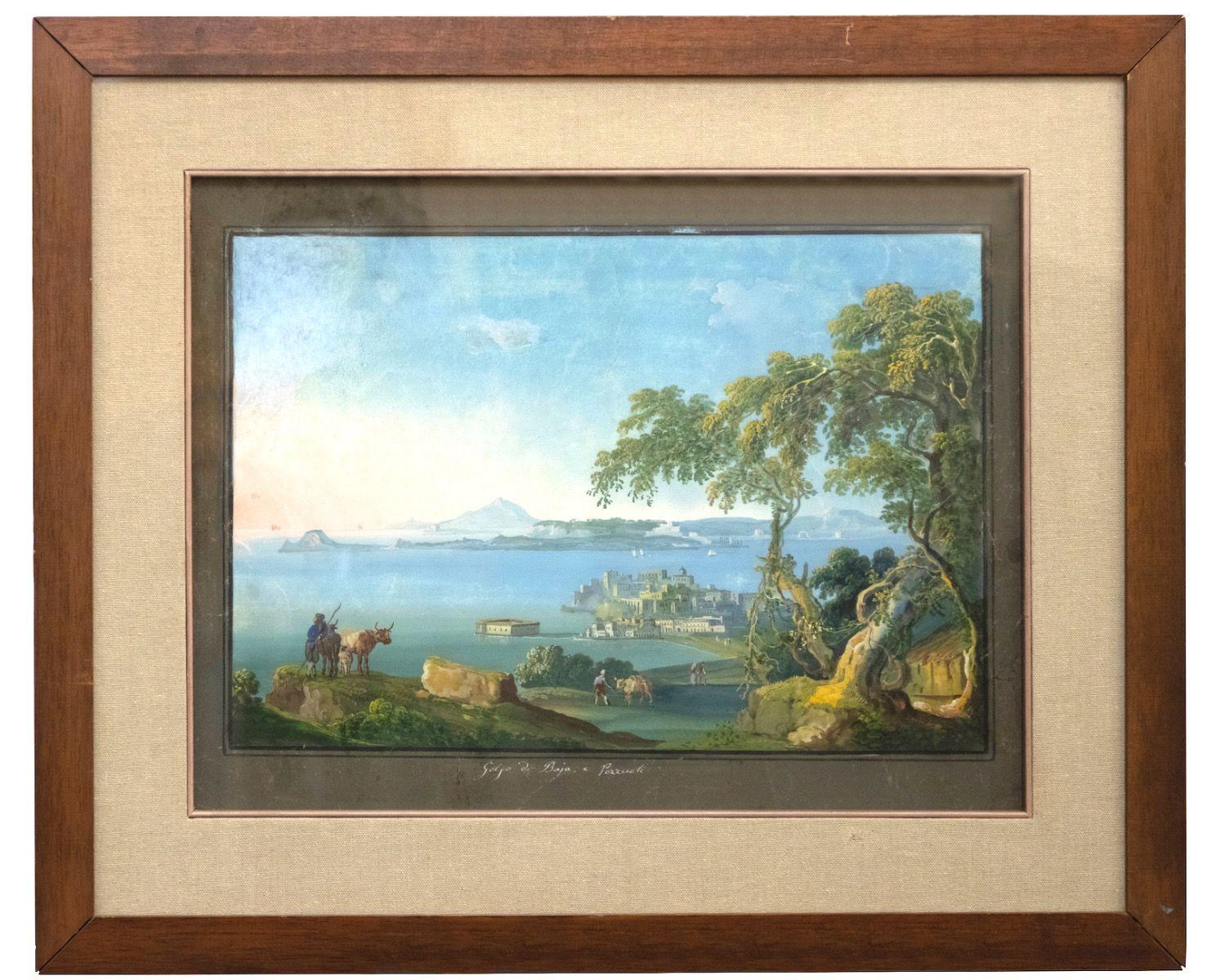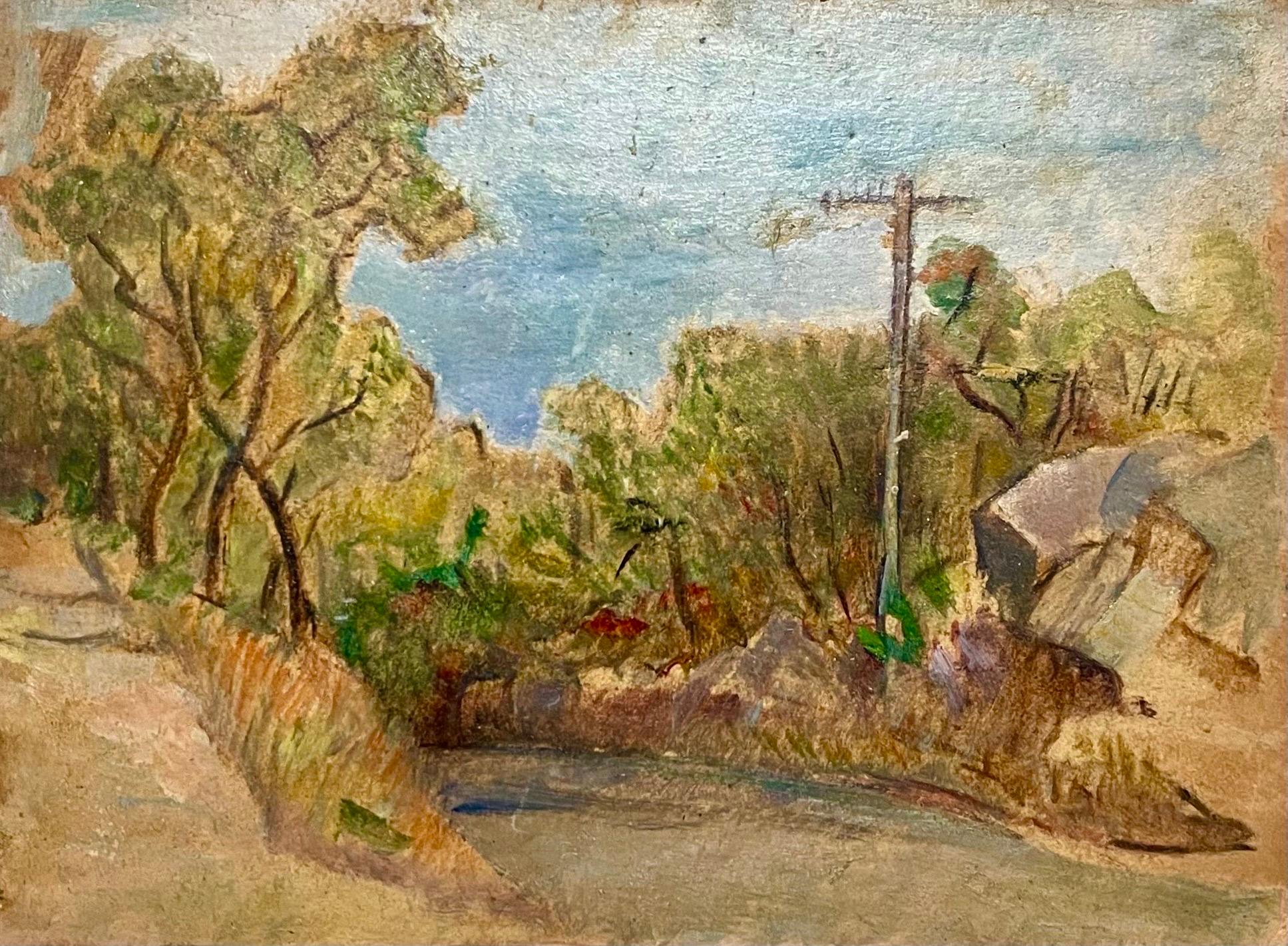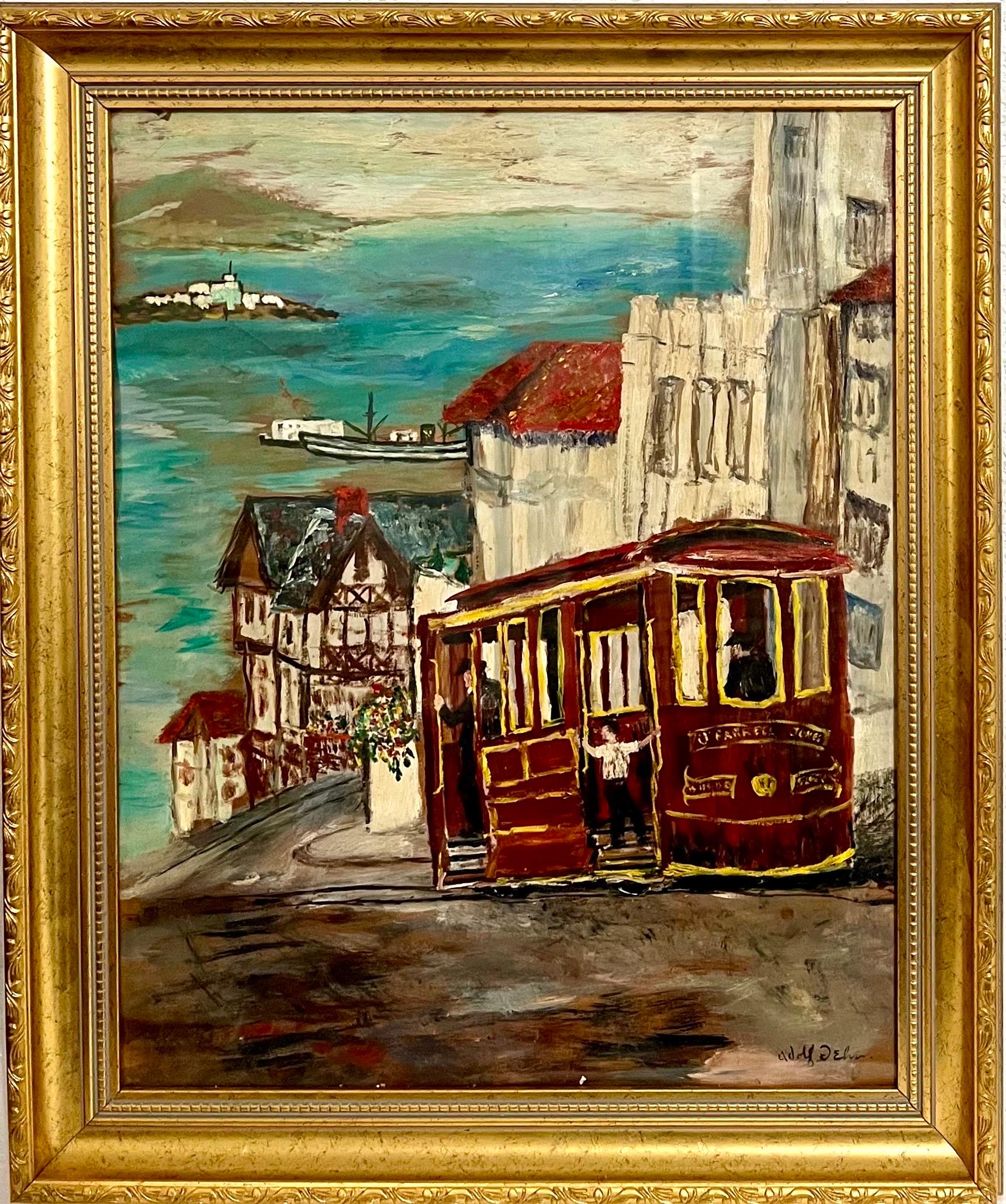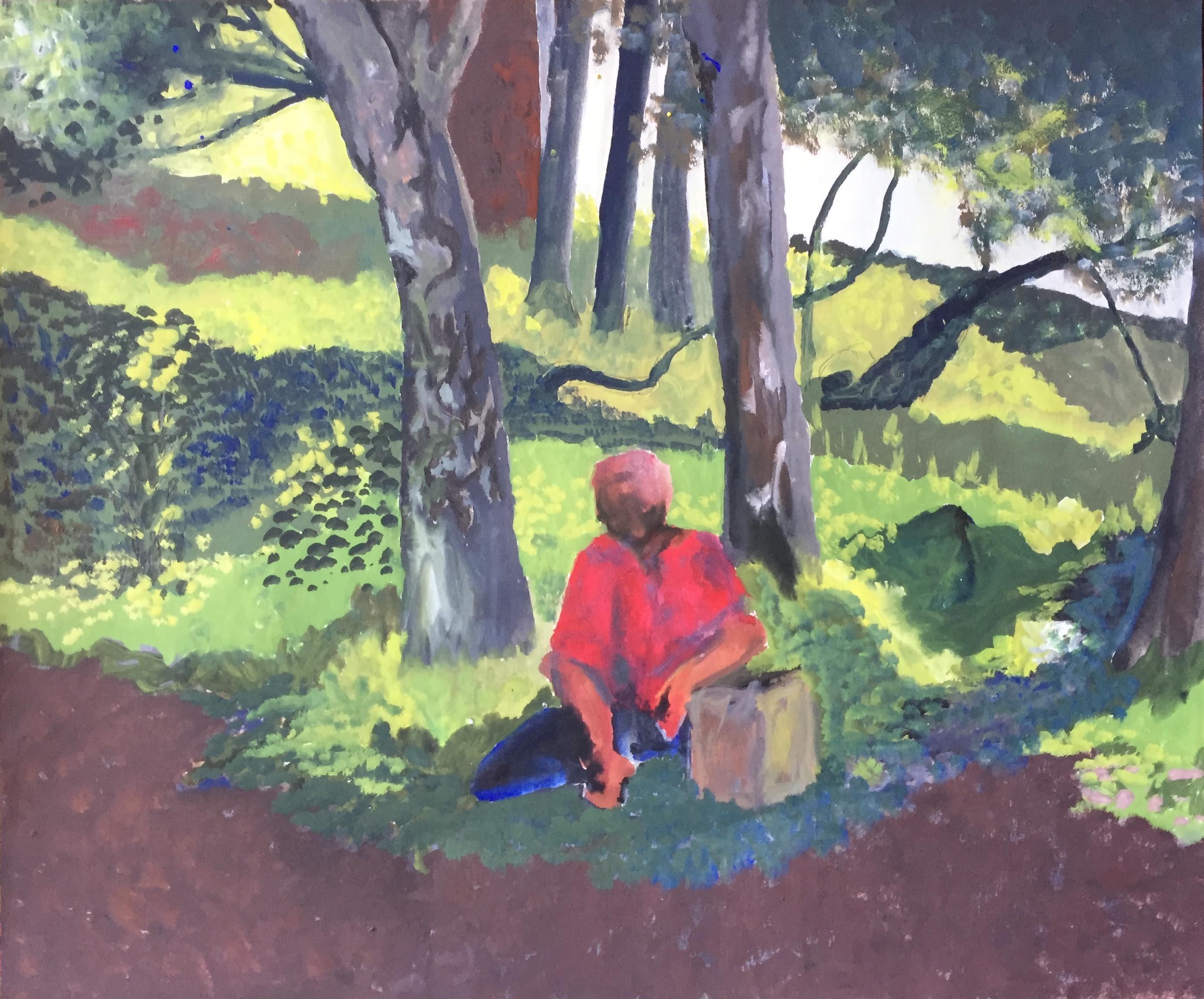Items Similar to Petit Rhône, Gouache varnish on cardboard
Want more images or videos?
Request additional images or videos from the seller
Pierre CharbonnierPetit Rhône, Gouache varnish on cardboard
About the Item
Pierre Charbonnier (1897-1978)
Small Rhone
Gouache varnish on cardboard
Signed "P. Charbonnier" and titled "Petit Rhône" lower right
15 x 20,5 inch
Frame : 50 x 70 cm
Born in 1897 in Vienne (Isère), Pierre Charbonnier was predestined for an artistic career from an early age. He received his first training at the School of Fine Arts in Lyon in 1915 before moving to Paris where he joined the Académie Ranson. He presented his first paintings at the Salon des Indépendants, the Salon des Tuileries and the Salon d'Automne in the early 1920s. He also exhibited in galleries in France (Henriette Gomès Gallery, Albert Loeb Gallery) and abroad (Italy, Japan, Brazil, Luxembourg). Active in the film industry, he also distinguished himself as a decorator, notably for the filmmaker Robert Bresson from 1934 to 1970, but also as a director.
The theme of water is very present in the work of Pierre Charbonnier who grew up on the banks of the Rhone. The title "Le Petit Rhône" (The Little Rhone) annotated in the lower right-hand corner of the gouache we are presenting allows us to identify the river, which can be seen in the background behind stylized branches, reduced to thin, black, criss-crossing flat tints. The artist often situates his landscapes and other urban views, without which it would not be easy to identify the places in question (Drôme, Sète, Lyon, Barcelona etc.). The palette, reduced to blue, yellow and brown, draws here a landscape at the limit of abstraction. Living between Paris and the Drôme, Pierre Charbonnier paints numerous refined urban views with a constant concern for framing that shows an eye for photographic and cinematographic shots. These sometimes reveal the frame of a window opening onto a large perspective.
His compositions are often very geometrical and put in scene urban elements in a static atmosphere. They are punctuated by large lines, sometimes horizontal, sometimes vertical, creating large voids. In the aftermath of the Second World War, his paintings illustrate in a falsely naive way the invasion of urban space by concrete constructions on which he poses an angelic gaze. As shown in the gouache we propose, the artist represents the modern city in full transformation, the city of factories and buildings integrating metal infrastructures and other long chimneys and technical materials such as the Pompidou Center inaugurated in 1977. Mostly inanimate, Pierre Charbonnier's landscapes made of pure and intense colors express the poetry of the modern post-war world. This refinement is also found in the artist's keen interest in poetry that he shares with his friends Max Jacob, Tristan Tzara, René Char, Jacques Prévert and Blaise Cendrars.
- Creator:Pierre Charbonnier (1897 - 1978, French)
- Dimensions:Height: 15.36 in (39 cm)Width: 20.48 in (52 cm)
- More Editions & Sizes:Original workPrice: $1,981
- Medium:
- Movement & Style:
- Period:
- Condition:Gouache chips and tiny cracks visible on photos.
- Gallery Location:PARIS, FR
- Reference Number:1stDibs: LU2661213695042
About the Seller
5.0
Vetted Seller
These experienced sellers undergo a comprehensive evaluation by our team of in-house experts.
Established in 2018
1stDibs seller since 2023
Typical response time: 5 hours
- ShippingRetrieving quote...Ships From: PARIS, France
- Return PolicyA return for this item may be initiated within 14 days of delivery.
More From This SellerView All
- Pierre Charbonnier, The Factory near the River, gouache on cardboardLocated in PARIS, FRPierre Charbonnier (1897-1978) The Factory near the River Gouache on cardboard 25,5 x 19,6 inch Frame : 50 x 70 cm Born in 1897 in Vienne (Isère), Pierre Charbonnier was predestined...Category
Mid-20th Century Modern Landscape Paintings
MaterialsGouache
- Aquarium, circa 1935, oil on panelBy Lydia RaddaLocated in PARIS, FRLydia Radda (1891-1967) Aquarium, circa 1935 Oil on panel Signed “Radda” lower right 13 x 16 inch Painter born in Corbeil-Essonnes in 1891, Julie Florent was active in Paris at the ...Category
Early 20th Century Modern Landscape Paintings
MaterialsOil, Paint
- Paris, Saint-Martin canal, c. 1989, oil on canvasLocated in PARIS, FREmilio Trad (né en 1953) Paris, Saint-Martin canal, c. 1989 Oil on canvas Signed lower right 25,5 x 31,5 inch Emilio Trad, an artist of Lebanese origin bo...Category
1980s Landscape Paintings
MaterialsOil, Canvas
- Hubert Aicardi, Landscape, tree trunks, 1964, oil on canvasLocated in PARIS, FRHubert AICARDI (1922-1991) Landscape, tree trunks, 1964 Oil on canvas Signed and dated "64" lower right 46 x 55 cm ubert Aicardi is a painter of the Provençal school born in Marseil...Category
Mid-20th Century Landscape Paintings
MaterialsOil
- Bilboquet player, 1879Located in PARIS, FRAfter an initial training at the Toulouse School of Fine Arts, Jules-Arsène Garnier joined the Paris School of Fine Arts in 1867 in Jean-Léon Gérôme's studio. As an academic artist, ...Category
1870s Figurative Paintings
MaterialsCanvas, Oil
- Poetry of the bird, surrealist drawing, 1948Located in PARIS, FRJoséphine Beaudouin (1909-2005) Poetry of the Bird, surrealist painting, 1948 Oil on canvas Signed "Joséphine Beaudouin" and dated "1948" lower left 13,7 x 10,6 inch Born in Albi in 1909, Josephine Beaudouin (née Cals) showed an early interest in drawing. At the age of twelve, she moved to Paris where her mother, Jeanne Ramel-Cals, ran a literary salon that was frequented by art world figures such as Ambroise Vollard. In 1925, while her first drawings appeared in the magazine Crapouillot, the young artist entered the School of Decorative Arts where she studied fresco painting. She married the architect Eugène Beaudouin in 1928, with whom she traveled throughout Europe. Beaudouin, a member of the Académie des Beaux-Arts, designed a series of buildings that were precursors of modern architecture in France (Clichy, Maison du Peuple; Antony, Résidence universitaire Jean Zay). Josephine Beaudouin exhibited at the Salon des Indépendants, the Salon des Tuileries, the Salon d'Automne and the Salon des Artistes Décorateurs. The work of the one that Jean Cocteau described as "bewitching" is full of mystery. Her work bears the stamp of an extraordinary personality. Indeed, Josephine Beaudouin developed a penchant for dreams at a very early age and took refuge in the works illustrated by Gustave Doré. Her technical virtuosity and overflowing imagination were praised by the critics of her time who unanimously greeted her Marmorées (ill.1). Named by René Barotte, these are paintings made on marble slabs from 1955. The artist exploits the infinite resources of the veins of this support which inspires him poetic compositions with unusual subjects. Marked by surrealism, she returns to the fantastic by delivering a prodigious creation of the mind made of dreamed cities and trompe-l'oeil. The 1948 painting that we propose probably represents a red-billed chough. The bird is a recurring theme in the work of Josephine Beaudouin, as in her life. An avid ornithologist, she kept an aviary in her Parisian home where many island birds were kept. She also built up a collection of stuffed birds. Still on this theme, the writer Claude Aveline (1901-1992), author of the poem L'Oiseau-Qui-N'Existe-Pas, invited several visual artists to freely interpret what this bird could be. The first series of works was produced between 1956 and 1963. In 1957, Joséphine Beaudouin delivered a work with a pen of great finesse, now preserved at the Centre Pompidou (ill.2). Several renowned artists also responded to the invitation of the poet such as Jean Cocteau and Ossip Zadkine. The precision of the graphics of our painting testifies to an attentive observation of the anatomy of the birds. The artist paints with great delicacy: the technique is impeccable, the drawing is careful, the material is smooth, the details are represented with great finesse and mastery. Bibliography : Fernand Pouillon...Category
1940s Surrealist Figurative Paintings
MaterialsOil, Canvas
You May Also Like
- Sicilian Landscape with Aetna on the Background - Gouache - Early 20th CenturyLocated in Roma, ITSicilian Landscape with Aetna on the Background is an original Gouache on paper, realized by Anonymous Artist of the early 20th Century. In very go...Category
Early 20th Century Modern Landscape Paintings
MaterialsGouache
- View of the Gulf of Naples, with Vesuvius on the background-Gouache-19th CenturyLocated in Roma, ITView of the Gulf of Naples, with Vesuvius on the background is an original modern artwork realized by Anonymous artist in the mid-19th Century. Mixed colored gouche. Includes a bla...Category
19th Century Modern Figurative Paintings
MaterialsGouache
- The Gulf and the Bay of Pozzuoli - Gouache - Early 19th CenturyLocated in Roma, ITTitled on lower center. Image 36.4x49 - 14.33 x 19.29 in. / Frame 54.7 x 66.5 - 21.54 x 26.18 in. Beautiful 19th century representation of the Gulf and the Bay of Pozzuoli near Nap...Category
Early 19th Century Modern Figurative Paintings
MaterialsGouache
- Simka Simkhovitch WPA Artist Oil Painting Gouache American Modernist PowerlineBy Simka SimkhovitchLocated in Surfside, FLSimka Simkhovitch (Russian/American 1893 - 1949) This came with a small grouping from the artist's family, some were hand signed some were not. These were studies for larger paintings. Simka Simkhovitch (Симха Файбусович Симхович) (aka Simka Faibusovich Simkhovich) (Novozybkov, Russia May 21, 1885 O.S./June 2, 1885 N.S.—Greenwich, Connecticut February 25, 1949) was a Ukrainian-Russian Jewish artist and immigrant to the United States. He painted theater scenery in his early career and then had several showings in galleries in New York City. Winning Works Progress Administration (WPA) commissions in the 1930s, he completed murals for the post offices in Jackson, Mississippi and Beaufort, North Carolina. His works are in the permanent collections of the Dallas Museum of Art, the National Museum of American Art and the Whitney Museum of American Art. Born outside Kyiv (Petrograd Ukraine) into a Jewish family who owned a small department store. During a severe case of measles when he was seven, Simcha Simchovitch sketched the views outside his window and decided to become an artist, over his father's objections. Beginning in 1905, he studied at the Grekov Odessa Art School and upon completion of his studies in 1911 received a recommendation to be admitted to the Imperial Academy of Arts. Though he enrolled to begin classes in architecture, painting, and sculpture at the Imperial Academy, he was dropped from the school roster in December because of the quota on the number of Jewish students and drafted into the army. Simchovitch served as a private in the 175th Infantry Regiment Baturyn [ru] until his demobilization in 1912. Re-enrolling in the Imperial Academy, he audited classes. Simka Simkhovitch exhibited paintings and sculptures in 1918 as part of an exhibition of Jewish artists and in 1919 placed 1st in the competition "The Great Russian Revolution" with a painting called "Russian Revolution" which was hung in the State Museum of Revolution. In 1922, Simkha Simkhovitch exhibited at the International Book Fair in Florence (Italian: Fiera Internazionale del Libro di Firenze). In 1924, Simkhovitch came to the United States to make illustrations for Soviet textbooks and decided to immigrate instead. Initially he supported himself by doing commercial art and a few portrait commissions. In 1927, he was hired to paint a screen for a scene in the play "The Command to Love" by Fritz Gottwald and Rudolph Lothar which was playing at the Longacre Theatre on Broadway. Art dealers began clamoring for the screen and Simkhovitch began a career as a screen painter for the theater. Catching the attention of the screenwriter, Ernest Pascal, he worked as an illustrator for Pascal, who then introduced him to gallery owner, Marie Sterner. Simkhovitch's works appeared at the Marie Sterner Gallery beginning with a 1927 exhibit and were repeated the following year. Simkhovitch had an exhibit in 1929 at Sterner's on circus paintings. In 1931, he held a showing of works at the Helen Hackett Gallery, in New York City and later that same year he was one of the featured artists of a special exhibit in San Francisco at the California Palace of the Legion of Honor in Lincoln Park. The exhibit was coordinated by Marie Sterner and included four watercolors, including one titled "Nudes". He is of the generation of Russian Soviet artists such as Isaac Pailes, Serge Charchoune, Marc Chagall, Chana Orloff, Isaac Ilyich Levitan, and Ossip Zadkine. In 1936, Simkhovitch was selected to complete the mural for the WPA Post office project in Jackson, Mississippi. The mural was hung in the post office and courthouse in 1938 depicted a plantation theme. Painted on the wall behind the judge’s bench, “Pursuits of Life in Mississippi”, a depiction of black workers engaged in manual labor amid scenes of white professionals and socialites, was eventually covered over in later years during renovations due to its stereotypical African American imagery. Simka painted what he thought was typical of Jackson. His impression of pre-civil rights Mississippi was evidently Greek Revival column houses, weeping willow trees, working class families, and the oppression of African Americans. He painted African American men picking cotton, while a white man took account of the harvest and a white judge advised a white family, calling it Pursuits of Life in Mississippi. Though clearly endorsed by the government and initially generally well-received, the mural soon raised concerns with locals as the climate toward racial segregation began to change. The main concern was whether depictions that show African Americans in subjugated societal roles should be featured in a courtroom. The following year, his painting "Holiday" won praise at an exhibition in Lincoln, Nebraska. In 1940, Simkhovitch's second WPA post office project was completed when four murals, "The Cape Lookout Lighthouse and the Orville W. Mail Boat", "The Wreck of the Crissie Wright", "Sand Ponies" and "Canada Geese" were installed in Beaufort, North Carolina. The works were commissioned in 1938 and did not generate the controversy that the Jackson mural had. The main mural is "The Wreck of the Crissie Wright" and depicts a shipwreck which had occurred in Beaufort in 1866. "The Cape Lookout Lighthouse and the Orville W. Mail Boat" depicted the lighthouse built in 1859 and the mail boat that was running mail during the time which Simkhovitch was there. The boat ran mail for the area until 1957. "Sand Ponies" shows the wild horses common to the North Carolina barrier islands and "Canada Geese" showed the importance of hunting and fishing in the area. All four murals were restored in the 1990s by Elisabeth Speight, daughter of two other WPA muralists, Francis Speight...Category
1930s American Modern Landscape Paintings
MaterialsGouache, Oil, Board
- San Francisco Cable Car WPA Artist Adolf Dehn Modernist Art Gouache Oil PaintingBy Adolf DehnLocated in Surfside, FLADOLF ARTHUR DEHN (American, 1895-1969) San Francisco Bay Area street scene, with Trolley, Streetcar, Cable Car with bay and Alcatraz Island in background. Hand signed LRC. Sight 19" x 15", overall 23" x 19". Adolf Dehn (November 22, 1895 – May 19, 1968) was an American artist known mainly as a lithographer. Throughout his artistic career, he participated in and helped define some important movements in American art, including regionalism, social realism, and caricature. A two-time recipient of the Guggenheim Fellowship, he was known for both his technical skills and his high-spirited, droll depictions of human foibles. Adolph Dehn was born in 1895 in Waterville, Minnesota. He began creating artwork at the age of six, and by the time of his death had created nearly 650 images. Dehn went to the Minneapolis School of Art (known today as the Minneapolis College of Art and Design), where he met and became a close friend of Wanda Gag. In 1917 he and Gág were two of only a dozen students in the country to earn a scholarship to the Art Students League of New York. He was drafted to serve in World War I in 1918, but declared himself a conscientious objector and spent four months in a guardhouse detention camp in Spartanburg, SC and then worked for eight months as a painting teacher at an arm rehabilitation hospital in Asheville, NC. Later, Dehn returned to the Art Students League for another year of study and created his first lithograph, The Harvest. In 1921 Dehn's lithographs were featured in his first exhibition at Weyhe Gallery in New York City. From 1920 to 1921 in Manhattan, he was connected to New York's politically left-leaning activists. In 1921, he went to Europe. In Paris and Vienna he belonged to a group of expatriate intellectuals and artists, including Andrée Ruellan, Gertrude Stein, and ee cummings...Category
1930s American Modern Figurative Paintings
MaterialsOil, Gouache
- Mid Century Landscape Figure Painting Art Institute of SF Green, Red, BlueBy Gloria DudfieldLocated in Arp, TXGloria Dudfield (1922-2015) Untitled c.1960s Gouache on paper 18"x15" unframed Unsigned Came from a portfolio of her work in the San Francisco Bay Area. Gloria had a Master of Arts...Category
Mid-20th Century Modern Figurative Paintings
MaterialsGouache, Paper





